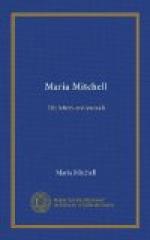“COLLEGIO ROMANO; SECCHI. There was another observatory which had a reputation and was known in America. It was the observatory of the Collegio Romano, and was in the monastery behind the Church of St. Ignasio. Its director was the Father Secchi who had visited the United States, and was well known to the scientists of this country.
“I said to myself, ’This is the land of Galileo, and this is the city in which he was tried. I knew of no sadder picture in the history of science than that of the old man, Galileo, worn by a long life of scientific research, weak and feeble, trembling before that tribunal whose frown was torture, and declaring that to be false which he knew to be true. And I know of no picture in the history of religion more weakly pitiable than that of the Holy Church trembling before Galileo, and denouncing him because he found in the Book of Nature truths not stated in their own Book of God—forgetting that the Book of Nature is also a Book of God.
“It seems to be difficult for any one to take in the idea that two truths cannot conflict.
“Galileo was the first to see the four moons of Jupiter; and when he announced the fact that four such moons existed, of course he was met by various objections from established authority. One writer declared that as astrologers had got along very well without these planets, there could be no reason for their starting into existence.
“But his greatest heresy was this: He was tried, condemned, and punished for declaring that the sun was the centre of the system, and that the earth moved around it; also, that the earth turned on its axis.
“For teaching this, Galileo was called before the assembled cardinals of Rome, and, clad in black cloth, was compelled to kneel, and to promise never again to teach that the earth moved. It is said that when he arose he whispered, ‘It does move!’
“He was tried at the Hall of Sopre Minerva. In fewer than two hundred years from that time the Church of St. Ignasio was built, and the monastery on whose walls the instruments of the modern observatory stand.
“It is a very singular fact, but one which seems to show that even in science ‘the blood of the martyrs is the seed of the church,’ that the spot where Galileo was tried is very near the site of the present observatory, to which the pope was very liberal.
“From the Hall of Sopre Minerva you make but two turns through short streets to the Fontenelle de Borghese, in the rear of which stands the present observatory.
“Indeed, if a cardinal should, at the Hall of Sopre Minerva, call out to Secchi, ‘Watchman, what of the night?’ Secchi could hear the question; and no bolder views emanate from any observatory than those which Secchi sends out.
“I sent a card to Secchi, and awaited a call, well satisfied to have a little more time for listless strolling among ruins and into the studios. And so we spent many an hour: picking up land shells from the top of the Coliseum, gathering violets in the upper chambers of the Palace of the Caesars,—for the overgrown walls made climbing very easy,—or, resting upon some broken statue on the Forum, we admired the arches of the Temple of Peace, thrown upon the rich blue of the sunny skies.




